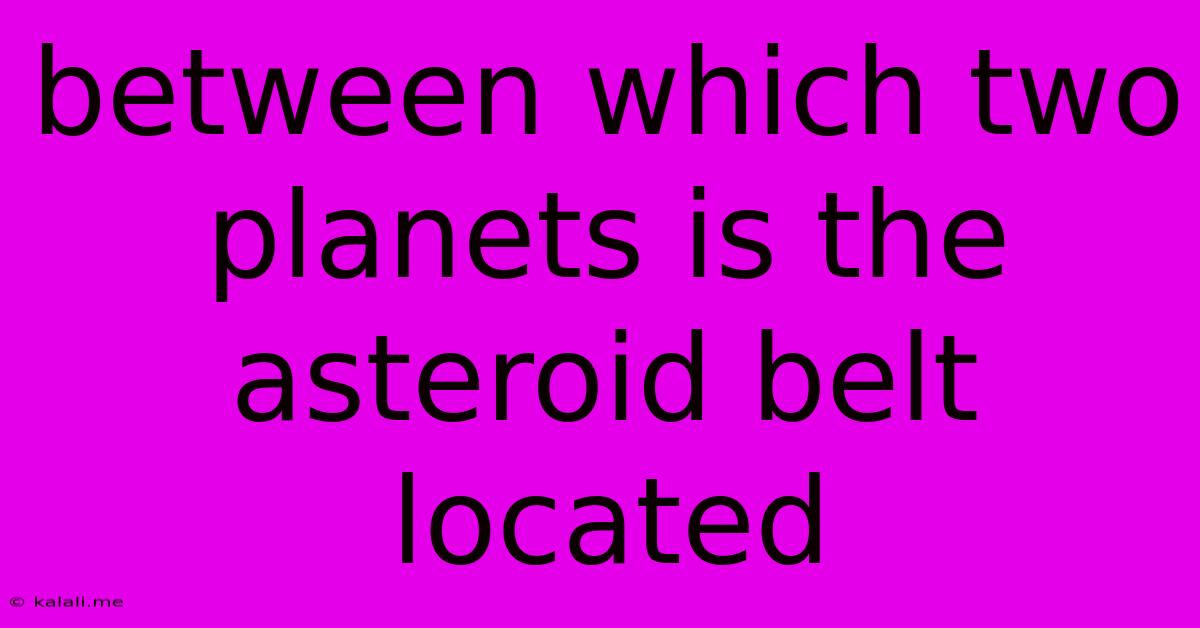Between Which Two Planets Is The Asteroid Belt Located
Kalali
Jun 14, 2025 · 3 min read

Table of Contents
Between Which Two Planets is the Asteroid Belt Located?
The asteroid belt, a fascinating region of our solar system, lies between the orbits of Mars and Jupiter. This vast expanse, teeming with countless rocky bodies of varying sizes, is a leftover remnant from the early formation of our solar system. Understanding its location helps us grasp the dynamics of planetary formation and the gravitational influences that shaped the solar system we know today.
This article delves deeper into the asteroid belt's location, its composition, and the reasons behind its unique placement.
The Asteroid Belt: A Leftover from Planetary Formation
The prevailing theory about the asteroid belt's formation suggests it represents material that failed to coalesce into a planet. During the early stages of the solar system, dust and gas particles began to clump together, gradually growing larger through accretion. In most regions, this process led to the formation of planets. However, Jupiter's immense gravity, the solar system's largest planet, is believed to have disrupted the accretion process in the region between Mars and itself. Jupiter's powerful gravitational pull likely scattered many of the planetesimals, preventing them from forming a single, large planet and instead leaving behind a vast field of smaller, irregularly shaped asteroids.
Composition of the Asteroid Belt
The asteroid belt isn't a uniformly distributed cloud of rocks. Instead, it contains a diverse population of celestial bodies ranging in size from pebbles to hundreds of kilometers in diameter. Asteroids are generally categorized into three main types based on their composition:
- C-type (carbonaceous) asteroids: These are the most common type, composed primarily of clay and silicate rocks. They are dark in color and relatively primitive, representing some of the oldest material in the solar system.
- S-type (silicaceous) asteroids: These asteroids are composed mainly of silicate minerals and nickel-iron. They are brighter than C-type asteroids and are more common in the inner part of the asteroid belt.
- M-type (metallic) asteroids: These asteroids are largely composed of metallic iron and nickel. They are thought to be the cores of larger asteroids that were shattered by collisions.
Beyond these major classifications, numerous smaller sub-groups exist, reflecting the complex history and diverse formation processes within the asteroid belt.
The Significance of the Asteroid Belt's Location
The asteroid belt's position between Mars and Jupiter is crucial for several reasons. It highlights the significant influence of Jupiter's gravity on the early solar system and provides valuable insights into the formation and evolution of planets. The study of asteroids can reveal clues about the conditions present during the early stages of the solar system's formation. Analyzing their composition helps us understand the building blocks of planets and the processes that led to the diversity of planetary bodies we see today. Moreover, the asteroid belt acts as a reservoir of relatively pristine material from the early solar system, offering scientists a glimpse into the past.
Conclusion
In conclusion, the asteroid belt is located between the planets Mars and Jupiter. Its existence, composition, and location provide invaluable evidence of the processes that shaped our solar system. Further exploration and research continue to unlock new insights into this fascinating region, furthering our understanding of planetary formation and the history of our cosmic neighborhood.
Latest Posts
Latest Posts
-
Force Per Unit Area Is Termed
Jun 15, 2025
-
Least Common Multiple Of 3 4 And 8
Jun 15, 2025
-
Function Of The Fine Adjustment Knob
Jun 15, 2025
-
What Is Not Found In Prokaryotic Cells
Jun 15, 2025
-
Point Loma Nazarene University Gpa Requirements
Jun 15, 2025
Related Post
Thank you for visiting our website which covers about Between Which Two Planets Is The Asteroid Belt Located . We hope the information provided has been useful to you. Feel free to contact us if you have any questions or need further assistance. See you next time and don't miss to bookmark.